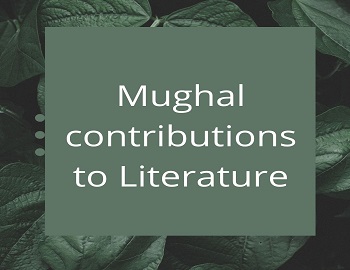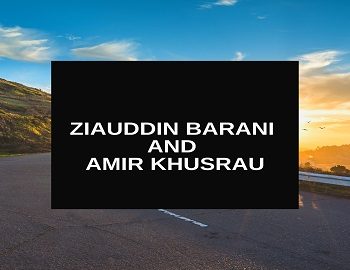Mughal contributions to Literature:
The Mughal Age produced a rich treasure of literature, and the literary and artistic developments combined together amply justify the description of this period ‘the Second Classical Age”. Some of the Mughal rulers like Babur, Humayun, Jahangir and many Mughal princes and princesses were themselves great literary personalities. Some other rulers like Akbar and Shah Jahan, who were themselves not great authors, were, however, great patrons of literature. The greatest literary development during the period took place not only in the field of Persian literature, which was the court language but also in several Indian and non-Indian languages like Hindi, Bengali, Marathi, Urdu and Arabic that brought forth a vast treasure of literary compositions.
The Persian literature of the Mughal period covers extensive ground but it is especially very rich in historical works. Babur himself was a refined scholar and the excellence of his Memoirs. He wrote his Autobiography Tuzuk-i-Baburi or Baburnamah in Chagatai Turk language. Waqiat-i-Baburi has been universally recognized. He has been styled as the prince of biographers. But it was Akbar’s patronage that gave a vigorous stimulus to literacy activity. Akbar, though illiterate, built up a splendid library that contained 24,000 manuscripts. The Persian literature of Akbar’s time comprised historical works translation and poetry. The great historical works of his reign are-
| Work | Author |
|---|---|
| Akbar Namah, Ain-i-Akbari | Abul Fazl |
| Tabqat-i-Akbari | Nizamuddin Ahmad |
| Humayun Namah | Gulbadan Begum |
| Mintakhab-ul-Tawarikh | Abdul Qadir Badyuni’s |
| Tarikh-i-Alfi | Mulla Daud |
| Manavi Nal-o-Daman | Abul Faizi |
| Tuhfa-i-Akbarshahi alias Tarikh-i-Sher Shahi | Abbas Khan Sherwani |
Abul Fazl stood head and shoulders above all the writers of the age. He was a great poet, a critic and a historian. Akbar was a keen student of Hindu culture and so by his order, many Sanskrit works were translated into Persian-
| Translated Work (in Persian) | Author |
|---|---|
| Ramayana | Abdul Qadir Badyuni’s |
| Mahabharata | Several Muslim scholars under the title of Razmnama |
| Lilavati (work of Hindu Mathematics) | Abul Faizi |
| Atharva Veda | Hazi Ibrahim Sarhindi |
| Bhagavata Purana | Todarmal |
Persian literature continued to flourish under Akbar’s successors. Jahangir, himself a scholar and critic, wrote his own autobiography in imitation of his great grandfather Babur and named it Tuzuk-i-Jahangiri. Among important historical works are-
| Work | Author |
|---|---|
| Maasir-i-Jahangiri | Kamgar Khan |
| Iqbalnama-i-Jahangiri | Mutamad Khan |
During the reign of Shah Jahan, besides many poets and theologians, there flourished in his court some famous writers of history like-
| Work | Author |
|---|---|
| Padshahnamah | Abdul Hamid Lahori |
| Padshahnamah | Amini Qazwini |
| Shahjahannama | Inayat Khan |
Shah Jahan’s eldest son Dara Shikoh was a great scholar of Arabic, Persian and Sanskrit and was the author of many works on Sufi philosophy and on the biographies of Muslim Saints. His most original work was Majm-ul-Bahrain or the Mingling of the Oceans, in which he attempted to show that Hinduism and Islam were two paths to one goal.
Aurangzeb had no taste for poetry and was opposed to the writing of the history of his period. Yet several important histories were written during his time. Some of these were-
| Work | Author |
|---|---|
| Muntakhab-ul-lubab | Khafi Khan |
| Alamgirnama | Mirza Muhammad Qazim |
| Nushkha-i-Dilkusha | Bhim Sen |
| Khulasa-ut-Tawarikh | Sujan Rai |
| Maasir-i-Alamgiri | Ishwar Das Nagar |
| Fatwa-i-Alamgiri | Aurangzeb |
The 16th and 17th centuries saw the development and growth of Hindustani literature. The first writer of note after 1526 was Malik Muhammad Jaysi who in 1540 wrote the fine philosophic epic the Padmavat. Akbar’s keen interest in and patronage of Hindi poetry gave a great stimulus to Hindi literature. Among the courtiers of Akbar, Birbal, Raja Man Singh and Raja Bhagwan Das were famous poets. The most distinguished writer among the ministers was Abdur Rahim Khan-i-Khana. The political literature of the time was mostly religious. Their themes were taken generally from the cult of Rama or Krishna. Among the poets who popularized the cult of Rama the most famous was Tulsidas. His famous work was the Ramcharitmanas that is a veritable Bible for the Hindus of north India. Elsewhere, Ramayana became popular, mainly through the efforts of Kamban in the Tamil country, Kirttivasa in Bengal and Ezhuthachan in Kerala. The revival of Braja Bhasa and the great literary masters the language produced- Keshav Das and Surdas highlighted the intellectual fervour of the period.
The Mughal period also witnessed the efflorescence of Sanskrit literature in the north. The most famous of the Sanskrit writers of the period was Jagannatha Pandita, honoured by Shah Jahan with the title of Kaviraja. His Ganga Lahari and other works are rightly considered classics. Rupa Goswami, the author of the drama Vidagdha Madhava and the playwright Giridharnatha were other notable poets during the period.
In Bengal, there was a brilliant outburst of Vaishnava literature. Among the famous Vaishnava writers may be mentioned Krishnadas Kaviraj, the author of Chaitanya Charitamrita, Brindaban Das, the author of Chaitanya Bhagavata, Jayananda the author of Chaitanya Mangal, Trilochan Das and Narahari Chakravarti.


![Muslim League [December 30, 1906] 3 Muslim League](https://gkscientist.com/wp-content/uploads/2021/05/Muslim-League.jpg)






Comments (No)